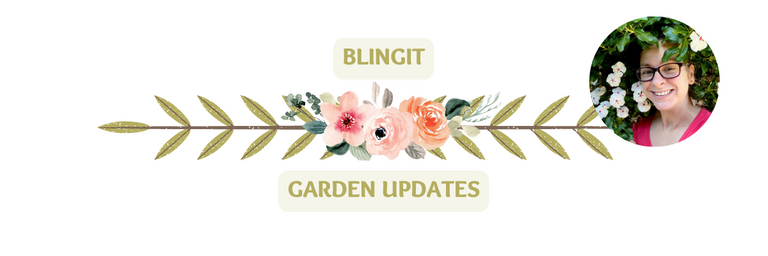
Good morning, everyone, and welcome back to the Urban Garden blog. Today, I'm transforming my once-yucca-filled oasis into a bountiful backyard of fresh produce. I usually begin with apologies for my sparse posting schedule, and as usual, I'll make up for it with an extensive end-of-year update. I'm excited to take you on a tour of the garden, sharing updates and the various activities keeping us busy.
Lately, we've been mowing the lawn every two days (quite the routine!), cleaning the fragrant chicken coop due to daily storms, and managing invasions of cane toads and snails. We've also cleared out the tomato bed, successfully revitalized the back garden bed, turned the compost heap, and cleaned the back deck and porch area.
However, it's been a challenging time with the severe storms that hit around Christmas Eve and Christmas Day — the worst I've ever experienced. The forecasts warned of severity, but the reality was devastating. Tragically, several people lost their lives in the fierce thunderstorms, which also spawned a mini tornado and left over 130,000 people without power. A friend of mine lost their roof; the destruction was widespread and heart-wrenching.
But as gardeners, we understand the resilience needed in the face of adversity. So, let's shift our focus back to the garden and the life it continues to nurture and sustain.


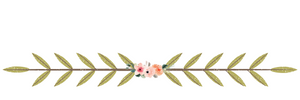
Firstly, let's dive into the situation with the chicken coop. We utilize the deep litter method, which is an effective, low-maintenance strategy that allows droppings and bedding material to accumulate and decompose within the coop itself. Typically, this creates a dry, non-odorous mixture that's excellent for the compost heap. However, with the relentless storms, a bit of water infiltrated the coop, disrupting the usually pleasant balance and resulting in a somewhat stinky situation.
Additionally, the area around the coop, where the chickens roam and leave their droppings on the grass, became rather pungent and attracted flies. The smell was compounded by the rain and, unfortunately, the dying cane toads nearby (a separate issue I'll address later), making the entire area quite unpleasant.
To tackle this, we first scattered garden lime around the lawn and inside the coop, which helps neutralize odors and reduce moisture. We raked it out a bit to spread it evenly. Then, we removed the wet bedding from the coop and replenished it with fresh pine shavings. It's important to note that we didn't remove all the bedding, as that would counteract the benefits of the deep litter method. On top of that, we used a fly bait — a spray designed to attract and eliminate flies — placed safely out of reach of our chickens.
After these measures, along with mowing the lawn,** the smell has significantly improved**. However, we still have the issue of the cane toads to contend with, which I'll cover next.
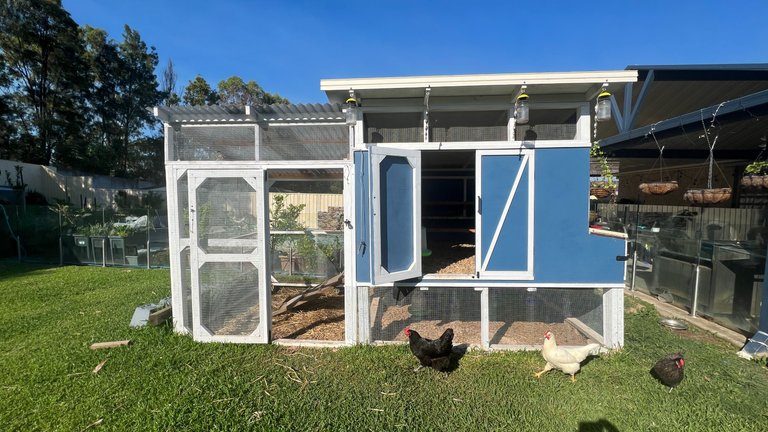


TOADS... Oh my, cane toads! Currently, we're experiencing an influx in the area, and everyone's buzzing about it on local social media. For those unfamiliar, cane toads (Rhinella marina) are large, non-native amphibians introduced to Australia in an attempt to control pest populations in sugar cane fields. This plan backfired dramatically, as these toads are **highly toxic and pose a significant threat to native wildlife, **pets, and even humans if ingested. Their poison glands can sicken or kill animals that try to eat them, including curious dogs or wildlife. While chickens sometimes eat small toads, cane toads' toxicity can pose a risk, so it's crucial to keep them separated.
These toads are not only a danger due to their poison but are also a nuisance. They leave behind large, sticky droppings and invade gardens and living spaces. They're gross, revolting, and a real menace to the Australian ecosystem.
In our efforts to control the population in our garden, I've resorted to using a cane toad spray that paralyzes and then kills them. While it's effective, sometimes I don't discover the toads quickly enough, and they end up dying in hidden spots. This leads to a horrendous situation — a stinking, maggot-infested mess that's nothing short of stomach-churning to clean up.
Living in Queensland and managing a property certainly comes with its unique challenges, and dealing with cane toads is one of the less glamorous aspects. We've managed to reduce the number of larger toads, but plenty of smaller ones are still hopping around. It's a constant battle to stay on top of them, but one that's necessary for the health of our garden and the local environment.


Next up: the great snail hunt! This morning, I awoke with a pounding headache, likely a souvenir from yesterday's intense gardening under the scorching sun. Despite this, I decided to water the seedlings at the bright and early time of 4:50 AM. Yes, that early... lol . And it was already sweltering! However, my early start revealed a surprise: my plants were besieged by hundreds of snails.
Armed with determination (and perhaps a bit of vengeance for my ailing seedlings), I went on a snail-collecting spree, gathering quite a bounty for the kids to marvel at when they wake up. As I patrolled the fence line, picking off the pesky mollusks, I had an audience of very eager chickens. They were ecstatic, anticipating the "treaties" they've come to expect during my garden patrols. Chickens, you see, are surprisingly effective in pest control, and they find snails to be quite the delicacy. Their excitement was palpable as they followed me up and down, knowing that each snail I plucked meant a tasty morsel for them. Ah happy chicken noises are so cute.
This little morning adventure not only helped protect my plants but also provided a natural treat for the chickens, illustrating the beautiful symbiosis in our garden. It's moments like these that remind me of the interconnectedness of all living things in our little ecosystem and the joys (and sometimes headaches) of gardening in Queensland's robust climate.


Lucky for you, I'm going to keep this next section concise as my nerve-damaged hand is protesting the typing and dictating. So, I'll simply list out the garden jobs we've been tackling, accompanied by plenty of photos for a more visual journey.
Tomato Bed Overhaul: First, I tackled the back tomato bed, removing the nearly deceased plants and a few lingering tomatoes. Despite the risk, I replanted new tomatoes in the same spot, hoping that the fresh soil I mixed in will rejuvenate the area. I braved the intense heat to mulch the bed, all in the name of juicy, homegrown tomatoes.
**Back Garden Bed Revival: **Next, the back garden bed, previously ravaged by an elusive Queensland pest, is finally looking healthy again. Whatever was attacking it (be it possum, rat, or mice) seems to have moved on, possibly deterred by the potent essential oils I've been spraying. The zucchinis and cucumbers are thriving, much to my delight.
Citrus Woes: Our citrus trees are battling leaf miner again. Despite my efforts, it's another year of struggling for control. It's frustrating as the infestation significantly affects the leaves and the overall health of the trees.
Pot Plant Redesign: I've been reassessing the pots around the garden, removing old plants and replacing them with varieties we'll actually consume. There's no point in having something we never eat when it could be a space for an extra cucumber or chili bush.
Floral Flourishes: The flower wall in hanging baskets is flourishing, adding a lovely splash of color and life to the garden.
Mega Porch Cleanup: We've also cleaned the entire area under the mega porch, ensuring it's fresh and welcoming.
Spa and Pool Enjoyment: With the summer heat upon us, the spa and pool area has been a frequent retreat for cooling off and relaxing.
Front Garden Plans: The front garden remains bare after a recent clear-out. We're still pondering what to plant and design for this space.
And that, my fellow garden enthusiasts, is a wrap. That's where we stand post-Christmas and just before the New Year. I wish you all happy gardening, a joyful New Year, and all the best for 2024. May your gardens flourish and your harvests be bountiful!



Below is the garden when we moved in - green - but nothing to eat
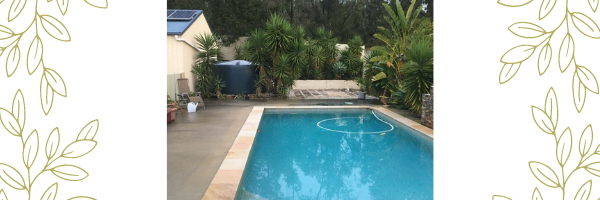

CONCLUDING MESSAGES
Just another very busy week all in all. I will now sign off and start the next video.. lol... as its already late as well
talk later
happy gardening
Sarah
Anyway thanks so much for stopping along and reading my posts I am just loving my HIVE experience so far. Such a fun platform for sure.
For those that don't know my i'm currently focusing on Daily painting and somewhat amusing my self and my family with Acrylic pouring.. lol.. i wish i had a separate studio for that as it is so messy.
My other HIVE interests are:
- cooking
sunset photography (i take photos of the sky every night)
Art
Graphic Design
Gardening (just a smidgion)
Ballet
Here are a couple of snaps of some of the stuff i do outside what you see up in the posts above.
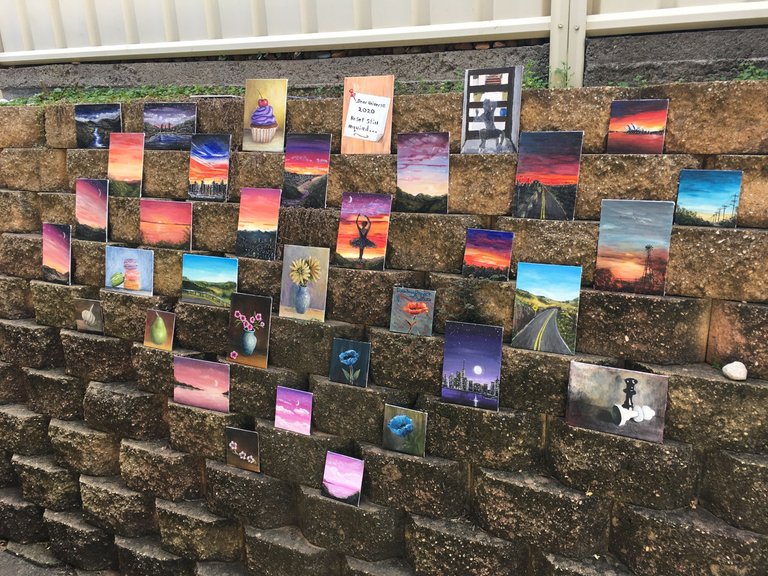
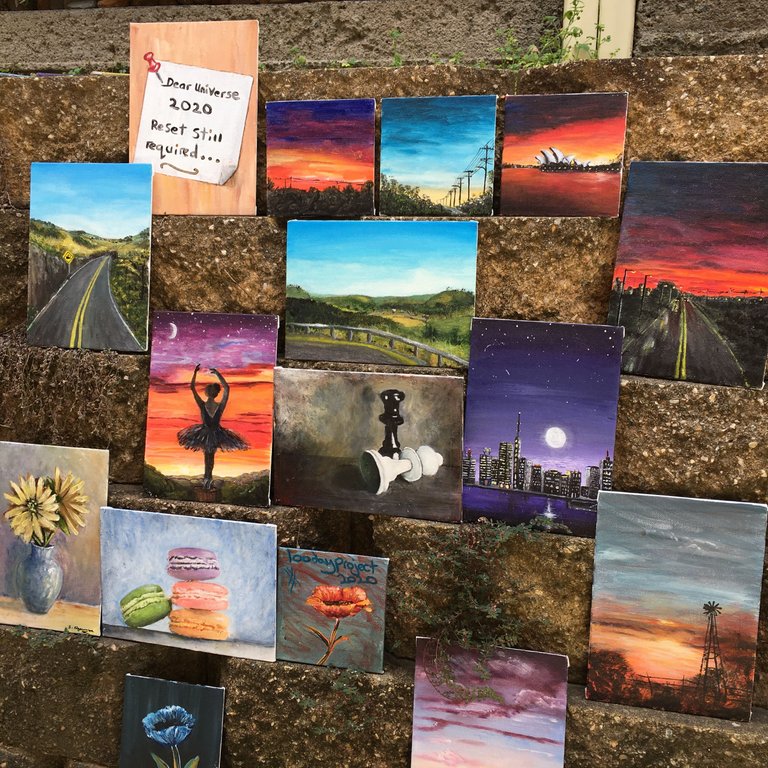
I am simply fascinated with everything you have done and see your photos, it is simply stimulating, I am a beginner at your side, I love to see your photos and read your lines.
PS: I am terrified of toads.
Thank you, its been a "educational" ride that is for sure. best advice is to grow something so you are self sufficient in one thing at a time. if you only grow a little of everything then you feel like "saving" it to use later and it rots. or you still need to buy the item from the supermarket anyway.
happy gardening!!!
https://reddit.com/r/UrbanGardening/comments/18t6q27/urban_garden_yearly_roundup_and_epic_snail_hunt/
The rewards earned on this comment will go directly to the people( @hiveborgminer ) sharing the post on Reddit as long as they are registered with @poshtoken. Sign up at https://hiveposh.com.
Congratulations @blingit! You have completed the following achievement on the Hive blockchain And have been rewarded with New badge(s)
Your next target is to reach 20000 upvotes.
You can view your badges on your board and compare yourself to others in the Ranking
If you no longer want to receive notifications, reply to this comment with the word
STOPTo support your work, I also upvoted your post!
Check out our last posts:
Epic post. Winter is here in the northern hemisphere so nothing to do but plan for next year...and clear snow haha. Understanding pests and dealing with them is a necessary part of gardening. No fun but part of the fight. We have frogs and snails but they are long gone until it warms back up. The flowers in hanging basket were one of the best things we did in our garden last year. Just makes it more inviting and a more pleasant space when you are doing one of the unpleasant tasks 🙂
Yeah little bugger of pests. They destroyed my ENTIRE winter crop of peas before i realised it. i wish we had frogs not toads... our green tree frogs are adorable... i need more flowers.. lol
What a fantastic garden post you have submitted and must mention that its very good.
By the way, I noticed that you used to publish through InLeo in the past, maybe you want to check The Week InLeo initiative!
There's a cool reward pool for those who join 🫡
You won't regret joining!